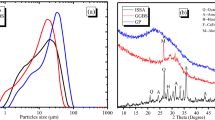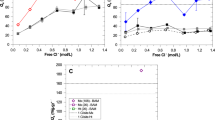Abstract
Efflorescence formation is an important soundness issue to be considered with alkali-activated cements. In this study, the impact of activator type on the efflorescence formation severity and methods of efflorescence reduction in alkali-activated phosphorus slag cement are investigated. Different alkaline activators including NaOH, KOH and liquid sodium silicate of different silica modules (Ms = SiO2/Na2O) were used for alkali-activation of phosphorus slag. Additions of high alumina cements (Secar 71 and 80) and application of hydrothermal curing condition at 85 °C for 7 h with different pre-curing times (1, 3 and 7 days) in humid environment (relative humidity of 95 %) and 25 °C were used for efflorescence control in alkali-activated phosphorus slag cement. Sodium containing activators resulted in more severe efflorescence formation compared with those of potassium containing activators. Also presence of liquid sodium silicate intensified efflorescence formation. Based on the results obtained, application of an optimum pre-curing stage in humid environment before hydrothermal curing regime stabilizes the cement matrix and improves the effectiveness of hydrothermal conditions.









Similar content being viewed by others
References
Allahverdi A, Mahinroosta M (2014) A model for prediction of compressive strength of chemically activated high phosphorous slag content cement. Int J Civil Eng 12(4 and A):481–487
Allahvedi A, Hashemi H (2015) Investigating the resistance of alkali-activated slag mortar exposed to magnesium sulfate attack. Int J Civil Eng 13(4 and A):379–387
Nwaubani S (2014) Hydration kinetics, pore characteristics and chloride ion diffusivity of blended cements. Int J Civil Eng 12(3 and A):354–362
Pacheco-Torgal F, Castro-Gomes JO, Jalali S (2008) Alkali-activated binders: a review part 1. Hist Backgr Terminol React Mech Hydr Prod Constr Build Mater 22(7):1305–1314
Torgal FP, Jalali S (2011) Eco-efficient construction and building materials. Springer, Berlin
Shi C, Krivenko PV, Roy DM (2006) Alkali-activated cements and concretes. Taylor & Francis, London
Altan E, Erdogan ST (2012) Alkali activation of a slag at ambient and elevated temperatures. Cement Concr Compos 34(2):131–139
Atis CD, Bilim C, Celik O, Karahan O (2009) Influence of activator on the strength and drying shrinkage of alkali-activated slag mortar. Constr Build Mater 23(1):548–555
Aydın S, Baradan B (2012) Mechanical and microstructural properties of heat cured alkali-activated slag mortars. Mater Des 35:374–383
Fernandez-Jimenez A, Puertas F, Sobrados I, Sanz J (2003) Structure of calcium silicate hydrates formed in alkaline-activated slag: influence of the type of alkaline activator. J Am Ceram Soc 86(8):1389–1394
Glukhovsky V, Rostovskaja G, Rumyna G (1980) High strength slag alkaline cements. In: Seventh international congress on the chemistry of cement, pp 164–168
Bernal SA, Provis JL, Rose V, Gutierrez RMD (2011) Evolution of binder structure in sodium silicate-activated slag-metakaolin blends. Cement Concr Compos 33(1):46–54
Li C, Sun H, Li L (2010) A review: the comparison between alkali-activated slag (Si + Ca) and metakaolin (Si + Al) cements. Cem Concr Res 40(9):1341–1349
Rovnaník P (2010) Effect of curing temperature on the development of hard structure of metakaolin-based geopolymer. Constr Build Mater 24(7):1176–1183
Siddique R, Klaus J (2009) Influence of metakaolin on the properties of mortar and concrete: a review. Appl Clay Sci 43(3–4):392–400
Fernandez-Jimenez A, Palomo A (2005) Composition and microstructure of alkali activated fly ash binder: effect of the activator. Cem Concr Res 35(10):1984–1992
Jaarsveld JGSV, Deventer JSJV, Lukey GC (2003) The characterisation of source materials in fly ash-based geopolymers. Mater Lett 57(1):1272–1280
Palomo A, Grutzek MW, Blanco MT (1999) Alkali-activated fly ashes. A cement for the future. Cem Concr Res 29(8):1323–1329
Oh JE, Monteiro PJM, Jun SS, Choi S, Clark SM (2010) The evolution of strength and crystalline phases for alkali-activated ground blast furnace slag and fly ash-based geopolymers. Cem Concr Res 40(2):189–196
Najafikani E, Allahverdi A (2009) Effect of chemical composition on basic engineering properties of inorganic polymeric binder based on natural pozzolan. Ceram Silik 53(3):195–204
Najafikani E, Allahverdi A (2009) Effects of curing time and temperature on strength development of inorganic polymeric binder based on natural pozzolan. J Mater Sci 44(12):3088–3097
Sajedi F, Razak HA (2010) The effect of chemical activators on early strength of ordinary Portland cement-slag mortars. Constr Build Mater 24(10):1944–1951
Puertas F, Fernandez-Jimenez A (2003) Mineralogical and microstructural characterisation of alkali-activated fly ash/slag pastes. Cem Concr Compos 25(3):287–292
Gao X, Yu QL, Brouwers HJH (2015) Properties of alkali activated slag–fly ash blends with limestone addition. Cem Concr Compos. 59:119–128
Allahverdi A, Kani EN (2013) Use of construction and demolition waste (CDW) for alkali-activated or geopolymer cements. In: Pacheco-Torgal F, Tam V, Labrincha J, Ding Y, de Brito J (eds) Handbook of recycled concrete and demolition waste. Woodhead Publishing, Cambridge, pp 439–475
Najafikania E, Allahverdib A, Provis JL (2012) Efflorescence control in geopolymer binders based on natural pozzolan. Cem Concr Compos 34(1):25–33
Bernal SA, Gutierrez RMD, Provis JL, Rose V (2010) Effect of silicate modulus and metakaolin incorporation on the carbonation of alkali silicate-activated slags. Cem Concr Res 40(6):898–907
Criado M, Palomo A, Fernández-Jiménez A (2005) Alkali activation of fly ashes. Part 1: effect of curing conditions on the carbonation of the reaction products. Fuel 84(16):2048–2054
Dow C, Glasser FP (2003) Calcium carbonate efflorescence on Portland cement and building materials. Cem Concr Res 33(1):147–154
Brocken H, Nijland TG (2004) White efflorescence on brick masonry and concrete masonry blocks, with special emphasis on sulfate efflorescence on concrete blocks. Constr Build Mater 18(5):315–323
Backbier L, Rousseau J, Bart JCJ (1993) Analytical study of salt migration and efflorescence in a mediaeval cathedral. J Franklin Inst 283(2):855–867
Merrigan PEM (1986) Efflorescence: cause and control. Masonry Soc J 1986:1–4
Škvára F, Kopecký L, Myšková L, Šmilauer V, Alberovská L, Vinšová L (2009) Aluminosilicate polymers—influence of elevated temperatures. Effloresc Ceram Silik 53(4):276–282
Škvára F, Šmilauer V, Hlaváček P, Kopecký L, Cílová Z (2012) A weak alkali bond in (N, K)–A–S–H gels: evidence from leaching and modeling. Ceram Silik 56(4):374–382
Maghsoodloorad H, Khaliliamiri H, Allahverdi A, Lachemi M, Hossain KMA (2014) Recycling phosphorus slag as a precursor for alkali-activated binder. Impact of type and dosage of activator. Ceram Silik 58(3):227–236
Shi C, Li Y (1989) Investigation on some factors affecting the characteristics of alkali-phosphorus slag cement. Cem Concr Res 19(4):527–533
Wang S-D, Scrivener KL, Pratt PL (1994) Factors affecting the strength of alkali-activated slag. Cem Concr Res 24(6):1033–1043
Qian G, Bai S, Ju S, Huang T (2013) Laboratory evaluation on recycling waste phosphorus slag as the mineral filler in hot mix asphalt. J Mater Civ Eng 25(7):846–850
Chang JJ (2003) A study on the setting characteristics of sodium silicate-activated slag pastes. Cem Concr Res 33(7):1005–1011
ASTM C230/C230 M-14 (2014) Standard specification for flow table for use in tests of hydraulic cement. In: ASTM international, West Conshohocken, PA
Škvára F, Kopecký L, Šmilauer V, Bittnarb Z (2009) Material and structural characterization of alkali activated low-calcium brown coal fly ash. J Hazard Mater 168(2–3):711–720
Bonk F, Schneider J, Cincotto MA, Panepucci H (2003) Characterization by multinuclear high-resolution NMR of hydration products in activated blast-furnace slag pastes. J Am Ceram Soc 86(10):1712–1719
Lee SK, Stebbins JF (2003) The distribution of sodium ions in aluminosilicate glasses: a high-field Na-23 MAS and 3Q MAS NMR study. Geochim Cosmochim Acta 67(9):699–1709
Allahverdi A, Škvára F (2001) Nitric acid attack on hardened paste of geopolymeric cements part I. Ceram Silik 45(3):81–88
Allahverdi A, Škvára F (2001) Nitric acid attack on hardened paste of geopolymeric cements. Part II. Ceram Silik 45(4):143–149
Hardjito D, Rangan BV (2005) Development and properties of low-calcium fly ash-based geopolymer concrete. Research Report GC 1. Curtin University of Technology, Perth
Hlavacek P (2014) Engineering properties of alkali activated composites. Czech Technical University in Prague (2014)
Puertas F, Palaciosc M, Manzanod H, Doladod JS, Ricof A, Rodríguezf J (2011) Model for the C–A–S–H gel formed in alkali-activated slag cements. J Eur Ceram Soc 31(12):2043–2056
Clayden NJ, Esposito S, Aronne A, Pernice P (1999) Solid state 27Al NMR and FTIR study of lanthanum aluminosilicate glasses. J Non-Cryst Solids 258(1–3):11–19
Lee TC, Li ZS (2014) Conditioned MSWI ash-slag-mix as a replacement for cement in cement mortar. Constr Build Mater 24(6):970–979
Deja J (2002) Immobilization of Cr6+, Cd2+, Zn2+ and Pb2+ in alkali-activated slag binders. Cem Concr Res 32(12):1971–1979
Sakulich AR, Anderson E, Schauer C, Barsoum MW (2009) Mechanical and microstructural characterization of an alkali-activated slag/limestone fine aggregate concrete. Constr Build Mater 23(8):2951–2957
García Alcocel E, Garcés P, Chinchón S (2000) General study of alkaline hydrolysis in calcium aluminate cement mortars under a broad range of experimental conditions. Cem Concr Res 30(11):1689–1699
Taylor HFW (1997) Cement chemistry. Thomas Telford, UK
Lecomte I, Henrista C, Liégeoisa M, Maserib F, Rulmonta A, Clootsa R (2006) (Micro)-structural comparison between geopolymers, alkali-activated slag cement and Portland cement. J Eur Ceram Soc 26(16):3789–3797
Bapat JD (2012) Mineral admixtures in cement and concrete. Taylor & Francis, Park Drive
Schneidera J, Cincottob MA, Panepucci H (2001) 29Si and 27Al high-resolution NMR characterization of calcium silicate hydrate phases in activated blast-furnace slag pastes. Cem Concr Res 31(7):993–1001
Richardson IG, Brough AR, Groves GW, Dobson CM (1994) The characterization of hardened alkali-activated blast-furnace slag pastes and the nature of the calcium silicate hydrate (C–S–H) phase. Cem Concr Res 24(5):813–829
Talling B, Brandstetr J (1989) Present state and future of alkali-activated slag concretes. In: 3rd inter conf on fly-ash, silica fume, slag and natural Pozzalans in concrete, Norway, pp 1519–1546
Li J, Yu Q, Wei J (2011) Structural characteristics and hydration kinetics of modified steel slag. Cem Concr Res 41(3):324–329
Taher MA (2007) Influence of thermally treated phosphogypsum on the properties of Portland slag cement. Conserv Recycl 52(1):28–38
Author information
Authors and Affiliations
Corresponding author
Rights and permissions
About this article
Cite this article
Maghsoodloorad, H., Allahverdi, A. Efflorescence Formation and Control in Alkali-Activated Phosphorus Slag Cement. Int J Civ Eng 14, 425–438 (2016). https://doi.org/10.1007/s40999-016-0027-0
Received:
Revised:
Accepted:
Published:
Issue Date:
DOI: https://doi.org/10.1007/s40999-016-0027-0




